Equation of first law of thermodynamics is mentioned below.
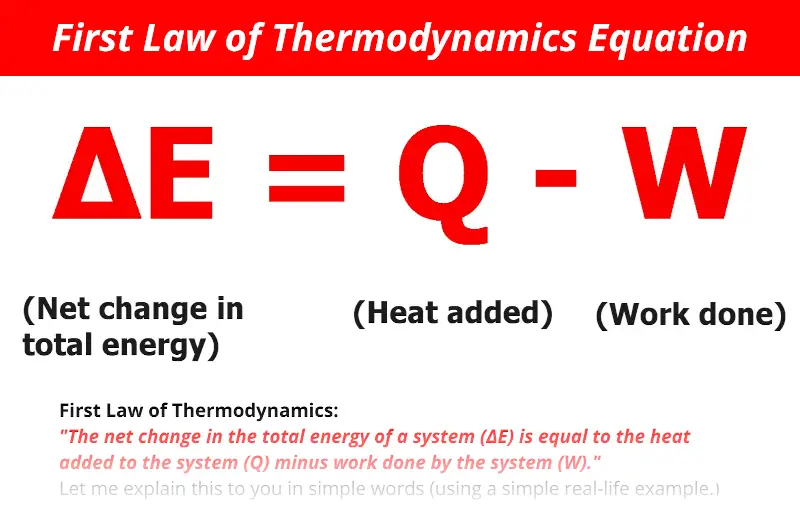
Let me tell you my own story.
When I was a student like you, I was really stuck with this confusing equation.
I was not getting the exact idea what this equation wants to say.
Then I studied from various sources (books, internet, as well as from my teacher), and finally I got the exact idea with a practical example.
Now I will explain the same, in easy way.
In fact the example which I have mentioned here makes me remember this first law of thermodynamics equation and statement very easily.
So let’s get started with the example.
Before that, here is a statement of first law of thermodynamics in terms of heat, work and internal energy.
“First law of thermodynamics: The net change in the total energy of a system (∆E) is equal to the heat added to the system (Q) minus work done by the system (W).”
Don’t worry, let’s take an example to understand this complicated statement.
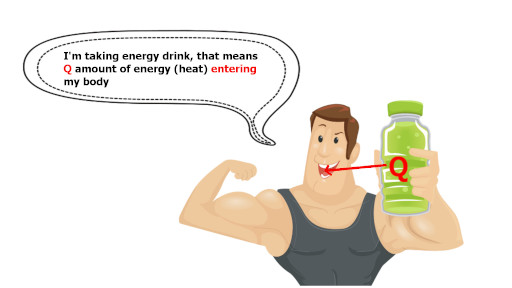
You can see in this picture that the muscular boy is taking energy drink which is having Q amount of energy.
Thus we can say that Q amount of energy is entering the body.
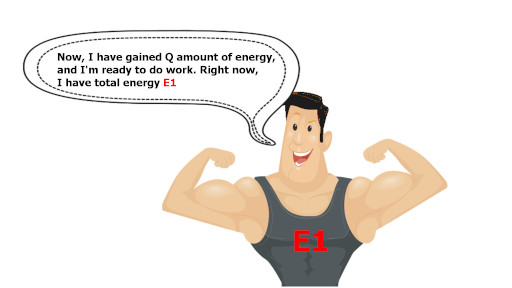
After taking the Q amount of energy, this muscular boy is now ready to do work. He is feeling energetic and he has now total energy of E1.
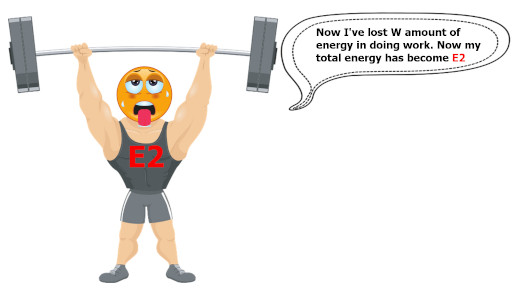
Now this picture shows that this muscular boy has lost some of his energy in doing the work (here weight lifting). After doing this work, his energy decreases to E2.
Now, let me explain these things with some equations.
It’s easy. Don’t worry.
Now here,
Q = Inlet energy to the body
W = Outlet energy in the form of work
E1 = Total energy that boy is having during initial state
E2 = Total energy that boy is having during the final state
Here, the body gains Q amount of energy as shown in the above image. And after sometime the body is spending some W amount of energy in doing work.
Hence the net change in total energy of the body is given by Q – W.
I told you guys that the boys total energy was E1 and then it became E2. Thus, this change in total energy is nothing but E2 – E1.
Above statement can be mathematically written as;
E2 – E1 = Q – W
Therefore, ∆E = Q – W
This equation is known as the equation for first law of thermodynamics.
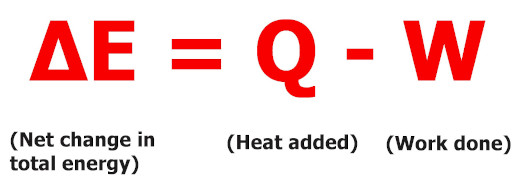
Now, you will easily understand the statement of the first law based on this equation.
“First law of thermodynamics: The net change in the total energy of a system (∆E) is equal to the heat added to the system (Q) minus work done by the system (W).”
In the above equation, the total energy ∆E is nothing but a sum of kinetic energy, potential energy and other energies present in the molecules of the body, which is also known as internal energy ∆U.
I’ve explained all these things later in this article. Don’t worry.
I have also explained the sign convention for work (W) and heat (Q). You will come to know when we should take the sign of work and heat as positive (+ve) and negative (-ve).
Keep reading.
Contents
What is heat (Q) in the equation of first law of thermodynamics?
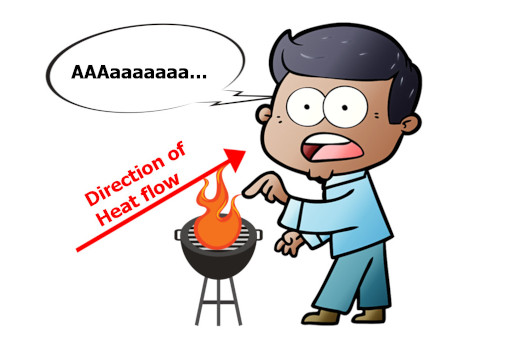
What happens when you touch a hot dish in a kitchen?
You feel it hot. But what exactly happens here?
It’s a flow of heat energy from the hot dish to your hand.
It’s a flow of heat energy from the higher temperature body to a lower temperature body.
That’s it !!
Now let us define heat.
Definition of heat:
Heat is defined as a flow of thermal energy due to differences in temperatures.
Heat is simply thermal energy in transit.
Very easy, isn’t it?
Sign convention of heat(Q) in the equation of first law of thermodynamics
When should we take the sign of heat (Q) as positive and when we should take it as negative?
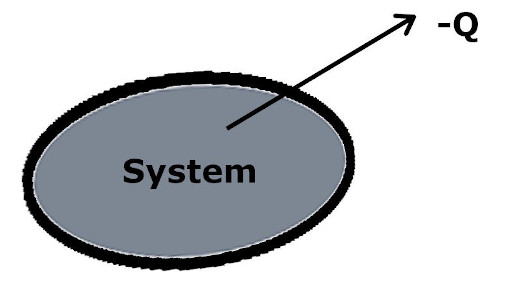
When the heat is lost from the system, then we have to take Q as -ve. (Remember, if heat is going then minus sign)
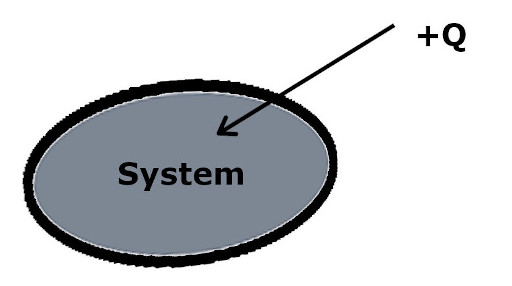
When the heat is supplied to the system, then we have to take Q as +ve. (Remember, if heat is coming then plus sign).
What is work (W) in the equation of first law of thermodynamics?
During the thermodynamic process, the volume of the system may increase or decrease.
Due to this increase or decrease in the volume, the thermodynamic work appears here.
But how will you decide whether the system is doing work on the surrounding or surrounding is doing work on the system?
Who is doing work on whom?
Don’t worry, I’ll make you understand this.
Let’s consider a piston cylinder assembly as shown below.
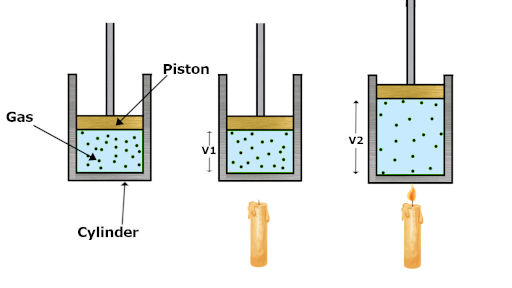
You can see that when heat is supplied to the system, then its volume increases.
Let;
V1 = initial volume of the system
V2 = final volume of the system
P = constant pressure of the system
See, here the pressure of the system remains constant because, as heat is supplied, the volume increases and thus the pressure remains constant or maintained inside the system.
The work done by the system can be obtained from following formula;
W = P (V2 – V1)
= P ∆V
Sign convention of work (W) in the equation of first law of thermodynamics
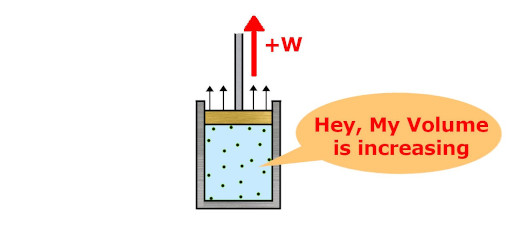
When the volume of the system increases, then we have to take sign of work W as +ve. This is a work done by the system. (Remember: Volume increases then plus sign for work)

When the volume of the system decreases, then we have to take sign of work W as -ve. This is a work done on the system. (Remember: Volume decreases then minus sign for work)
What is Internal energy in first law of thermodynamics equation?

There are small atoms in all the substances which possess various types of motion.
These motion can be;
- Rotational motion
- Vibrational motion
- Translational motion
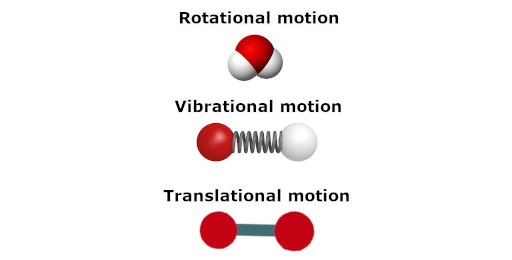
As these molecules are in motion inside the substance, the energy possessed by them is called kinetic energy.
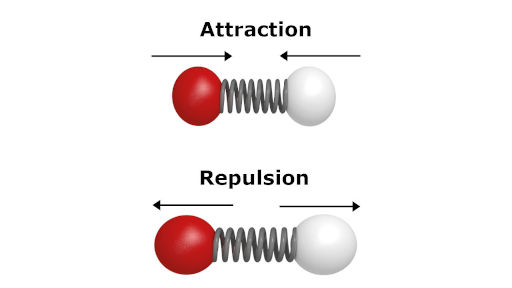
The molecules also possess attractive and repulsive forces. These forces indicate the potential energy between them.
Now, internal energy is nothing but a sum of all these molecular kinetic energy and molecules potential energy.

I hope you have understood everything about the first law of thermodynamics equation. Let me know in the comments if you have any queries.
Important Guides for you
Also read:
- What is thermodynamics? (35+ topics with definitions and examples)
- Zeroth law of thermodynamics
- More topics on first law of thermodynamics
- Examples of First Law of Thermodynamics / Law of conservation of Energy
- Limitations of First Law of Thermodynamics
- What is second law of thermodynamics? [8+ Best examples to remember the law]
- Examples of Second Law of Thermodynamics (8+ best examples)
- Second Law of Thermodynamics Definition/Statement (Next level explanation)
- Second Law of Thermodynamics Equation [Practical explanation]
- What is third law of thermodynamics? (in simple terms)
- Laws of thermodynamics
- What is Carnot Cycle in Thermodynamics?
- What is the definition of entropy in thermodynamics?
- Heat capacity vs specific heat in thermodynamics
- What is Thermodynamic Equilibrium? (With Best Example)
- Thermodynamic Process (With Examples)
- What is Thermodynamic System? – Open, Closed & Isolated system (With Examples)
